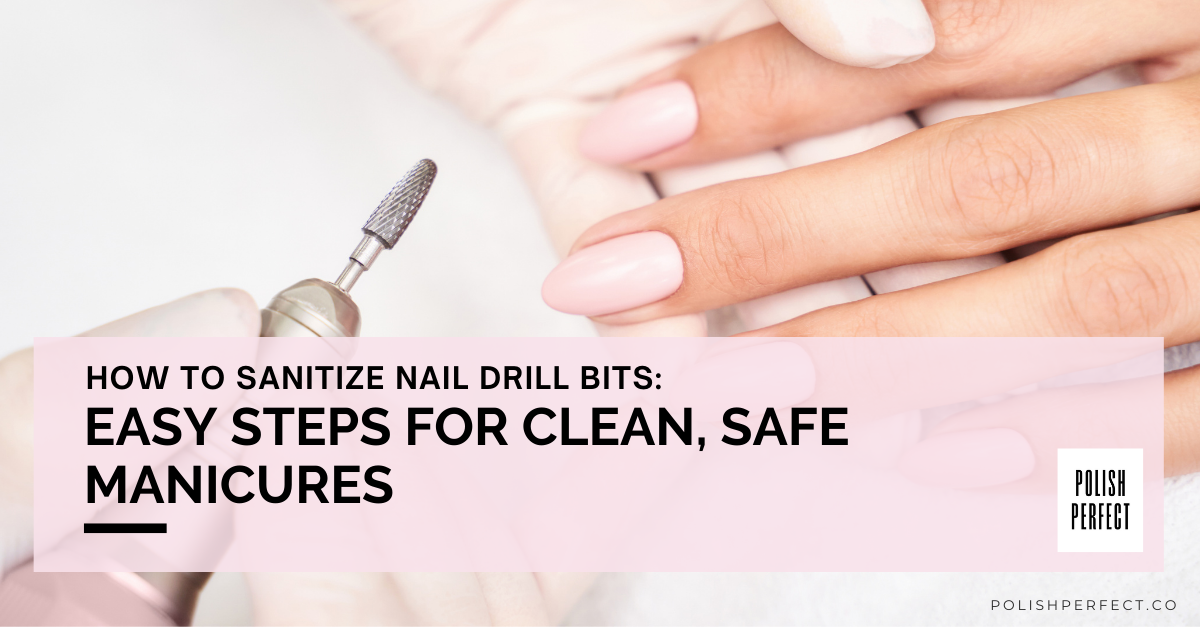You can use acetone to make your nail drill bits super clean? Acetone is like a superhero for your nail bits – it can even get rid of old nail stuff like acrylic, dip powder, and gel polish!
Sanitizing nail drill bits is critical for hygiene and tool maintenance.
Here’s a guide just for you to elevate our nail care.
Follow a step-by-step process on how to sanitize nail drill bits for effective results.
Now, let’s dive in!
Why Sanitizing Your Drill Bits Is Important
You might wonder why it’s so important to sanitize your nail drill bits.
Maintaining a clean and sanitary workspace is crucial, not only for your clients’ health but also for the longevity of your tools.
Here’s why sanitizing your drill bits should be a top priority.
First, let’s talk about bacteria and germs.
Nail drill bits come into contact with clients’ nails and skin throughout the service, making it possible for microscopic baddies to hitch a ride.
Without proper sanitation, these pesky microorganisms can easily transfer between clients, raising the risk of infections.
And we all know that a nail infection is definitely not fashionable at PolishPerfect.co (or anywhere).
Besides being a matter of cleanliness and client satisfaction, sanitizing your drill bits is an essential health and safety measure. You wouldn’t want to be held responsible for any health issues caused by dirty nail drill bits. No siree!
Sanitizing your tools helps uphold the professional image you’ve worked hard to build and maintain at your nail salon or workstation.
Here’s a quick list of benefits when you disinfect and sanitize your nail drill bits:
- Eliminate bacteria and germs.
- Reduce the risk of infections.
- Impress clients with a clean and safe environment.
- Extend the life of your tools.
- Comply with health regulations and requirements.
Now, while hand sanitizers and masks might be the recent stars of the show, don’t forget that taking care of your nail drill bits should be a non-negotiable part of your salon routine.
You’ve got this! Time to show those bacteria and germs who’s boss by properly sanitizing your nail tools.
Step-by-Step Process On How to Sanitize Nail Drill Bits
Things You Need
To properly sanitize your nail drill bits, you will need the following items:
- Clean cloth or paper towel
- A bowl of soapy water
- Acetone
- Wire brush
- A container for letting nail bits dry
Step 1: Wipe Nail Drill Bits To Remove Dust
Begin by using a clean cloth or a paper towel to gently wipe off any dust or debris from the nail drill bits. This step helps to ensure that the bits are clean before proceeding with the next steps.
Step 2: Clean Nail Drill Bits With Soapy Water
Fill a bowl with warm soapy water and place your nail drill bits into it. Gently scrub them with your hands or a soft toothbrush to remove any residual dirt and nail product buildup.
Make sure to clean every part of the bit, as any leftover debris can affect their performance.
Step 3: Use Acetone To Disinfect Nail Drill Bits
After you’ve cleaned the nail drill bits with soapy water, it’s time to disinfect them. Pour some acetone in a separate container and submerge your nail drill bits in it for a few minutes.
Acetone is an effective disinfectant that not only removes the remaining nail product but also kills germs and bacteria.
Step 4: Use a Wire Brush for Indented Cutting Flutes
Indented cutting flutes on the nail drill bits may be harder to clean using just soapy water and acetone. In this case, use a wire brush to gently scrub these areas, ensuring that all dirt and debris are removed.
Step 5: Allow the Nail Bits To Dry Completely
Finally, remove your nail drill bits from the acetone and place them on a clean cloth or paper towel.
Allow them to air dry completely before storing or using them again. Properly dried bits are essential to avoid any rust or damage.
By following these steps, you will effectively clean and disinfect your nail drill bits, ensuring their longevity and optimum performance for your personal or professional use.
Nail Drill Bit Disinfectants
When it comes to keeping your nail drill bits sanitized, there are several disinfectants you can use. In this section, we will discuss Acetone, Barbicide, Isopropyl Alcohol, and Soap Water & Bleach.
Choosing the right disinfectant for you depends on your preferences and the tools at your disposal.
Acetone
Acetone is a popular go-to choice for nail technicians, as it not only dissolves leftover nail products like acrylic, gel, or dip powder but also acts as a strong disinfectant killing germs and bacteria.
When using acetone to sanitize your drill bits:
- Soak the bits in acetone for a few minutes.
- Use a soft brush to scrub away any debris.
- Rinse the bits with water.
- Allow them to dry completely before storage.
Keep in mind that acetone can be harsh on some drill bit materials, so be cautious with prolonged exposure.
Barbicide
Barbicide is a widely recognized and EPA-registered disinfectant that’s perfect for sterilizing your nail drill bits. Here’s the rundown on how to use it:
- Mix Barbicide concentrate with water following the manufacturer’s instructions
- Soak your nail bits in the solution for the recommended time (usually 10 minutes)
- Remove bits from the Barbicide solution and rinse thoroughly with water
- Let the bits dry completely before storing them
Remember to store your mixed Barbicide solution in a closed container and replace it regularly, as per the manufacturer’s suggestions.
Isopropyl Alcohol
The use of isopropyl alcohol is also a popular method for cleaning and disinfecting nail drill bits. To use it effectively:
- Dip the bits in isopropyl alcohol for about 10 minutes
- Use a brush to remove any remaining debris
- Rinse the bits with water
- Allow them to dry completely before storing
Be sure to use at least 70% isopropyl alcohol to ensure proper sterilization.
Soap Water & Bleach
Finally, a mixture of soap water, and household bleach can be a cost-effective, DIY solution for sanitizing your nail drill bits. To work with this option, follow these steps:
- Mix a few drops of dish soap into warm water.
- Soak your bits in the soapy water for a couple of minutes.
- Create a bleach solution by mixing one part bleach and nine parts water.
- Soak the bits in the bleach solution for 10 minutes.
- Rinse thoroughly and let them dry before storage.
Utilizing one of the above disinfectants will help you maintain the hygiene and longevity of your nail drill bits, ensuring your toolset remains squeaky clean for your clients.
How to Clean Mandrels/Sanding Bands
Keeping your mandrels and sanding bands clean is essential to maintaining a professional appearance and ensuring the effectiveness of your nail tools.
As a nail technician or enthusiast, it’s important to take care of your equipment, especially since dirt and debris can accumulate on mandrels and sanding bands over time.
Here are some simple steps to keep your mandrels and sanding bands clean and well-maintained.
- First, remove any existing nail dust and debris from the sanding bands using a clean brush.
- Gently scrub the surface of the sanding bands, paying close attention to any metal or acrylic parts. This will help remove any dirt or buildup that may be hidden in the nooks and crannies of the band.
- Next, considering their disposable nature, replace sanding bands regularly. This ensures that you’re always working with a fresh, effective tool.
- Continuously using worn-down sanding bands can not only lead to less precise work but also make your job harder in the long run.
- When it comes to cleaning mandrels, start by washing them with warm, soapy water. Make sure to give them a thorough scrub, removing any lingering dirt or residue.
- Rinse the mandrels in clean water and gently pat them dry with a clean cloth.
To maintain the upkeep of your mandrels, consider investing in a 5-in-1 nail drill bit, which can help streamline your filing process, as well as save time and energy.
It’s crucial to remember that proper maintenance of your mandrels and sanding bands will help extend their life and ensure optimal performance.
By following these steps, you can keep your tools in pristine condition, impress your clients, and make sure your nail work stays at a top-notch level.
When Should You Clean Your Nail Drill Bits
Cleaning your nail drill bits is an essential part of this routine. So, when should you clean them?
First and foremost, clean your nail drill bits after each use.
This is possibly the most critical aspect of your tool maintenance that you should never ignore. By cleaning them right away, you prevent dust and product buildup, which makes sanitization a lot easier.
Simply use a soft brush or cloth to wipe away any residue after each manicure. This also ensures your nail drill bits are ready for your next client or personal use.
Besides cleaning after each use, it’s good practice to perform a deep cleaning of your nail drill bits periodically.
Integrating a more thorough cleaning procedure into your schedule helps keep them sparkling and free from stubborn dirt and grime.
Whether you choose to do this weekly or monthly will likely depend on how frequently your bits are touched by nails, but the aim is clear: don’t let the dirt accumulate.
While you establish your nail drill bit cleaning routine, consider the following essential tips:
- Use the right cleaning solution, such as acetone or soapy water, which effectively dissolves and removes any residual nail product.
- Always disinfect your nail drill bits by immersing them in an approved disinfectant to kill germs and bacteria.
- Make sure to store your clean and disinfected nail drill bits in a clean, dry container, away from potential contaminants.
Frequently Asked Questions
What’s the safest way to disinfect my diamond nail bits after each use?
You can safely disinfect your diamond nail bits by soaking them in isopropyl alcohol for about 10-15 minutes after each use.
Make sure the bits are fully submerged to ensure thorough disinfection. After soaking, remove the bits from the solution, rinse them under warm water, and let them air dry. This method is effective in killing bacteria and removing debris, keeping your nail drill bits hygienic and safe for use.
What are the no-fail steps to properly maintain electric nail drill bits?
Proper maintenance of your electric nail drill bits involves cleaning, disinfecting, and storing them appropriately.
Begin by disconnecting the drill from its power source and removing the bit. Scrub the bits gently with a soft brush to remove dust and debris.
Disinfect the bits as mentioned above, and once they’re dry, store them in a dry, clean, and organized container.
Regularly inspect your bits for damage or wear and replace them as needed. This 5-step process can help you keep your nail drill bits in top condition.
Can you give me some pro tips on cleaning and sanitizing electric nail file bits?
Certainly! Here are a few pro tips for cleaning and sanitizing electric nail file bits:
- Use appropriate cleaning tools, like a soft brush or gentle cloth, to avoid damaging the bits.
- Make sure to disconnect your nail drill from the power source for safety before cleaning.
- Regularly inspect your drill bits for signs of wear or damage, replacing them when needed.
- Keep a designated container or organizer for storing your clean and dry bits.
- Establish a routine for cleaning and sanitizing your bits after every use to maintain hygiene.
How often should I perform maintenance on my nail drill to ensure it’s in top condition?
To keep your nail drill in top condition, it’s recommended to clean and sanitize the drill bits after each use. This maintains nail hygiene and ensures the drill will always be ready for the next manicure session.
Additionally, inspect the bits for wear or damage periodically. Your nail drill itself may require less frequent maintenance – once a month should suffice.
Consult your manufacturer’s guidelines for specific recommendations on maintaining your particular nail drill.
What’s the best method to clean nail files without causing damage?
To clean nail files without causing damage, gently brush away debris with a soft brush. Avoid using harsh chemicals or rough materials, as these can damage the file’s surface.
If your nail file is washable, you can clean it with soapy water, rinse with warm water, and allow it to air dry. Be sure to follow the manufacturer’s instructions for the proper care of your specific nail file.
Are there common nail drill repairs I can do at home, and how do I avoid them with proper bit care?
Some common nail drill repairs that you may be able to handle at home include replacing worn or damaged bits, tightening loose parts, and unclogging dust vents.
Regular maintenance, such as cleaning and sanitizing your nail drill bits, can help prevent many common issues.
Additionally, always use the nail drill according to the manufacturer’s guidelines and avoid applying excessive pressure or force, as this can cause damage.
Proper care and cleaning of your nail drill will prolong its life and help you avoid repairs.
Final Thoughts
Taking care of your nail drill bits is essential for maintaining the effectiveness and longevity of your tools.
By keeping them clean, you’re not only prolonging their lifespan but also ensuring a safer environment for you and your clients.
Found our tips helpful? Comment below or share on social media to spread the perfection!



